2021-2022学年牛津译林版七年级英语下册Units3-4复习课件(重点考点 练习)(共20张PPT)
文档属性
| 名称 | 2021-2022学年牛津译林版七年级英语下册Units3-4复习课件(重点考点 练习)(共20张PPT) | 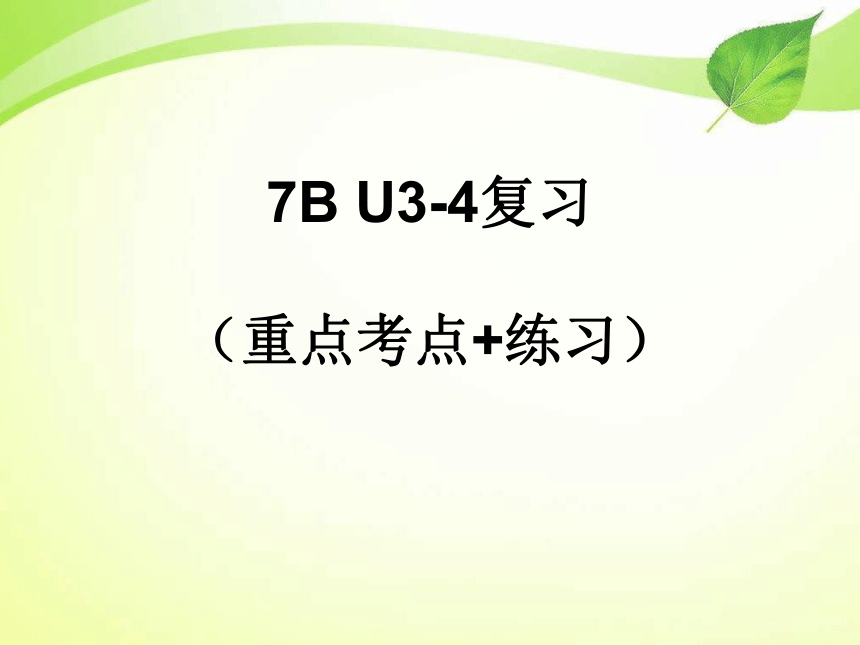 | |
| 格式 | zip | ||
| 文件大小 | 141.3KB | ||
| 资源类型 | 教案 | ||
| 版本资源 | 牛津译林版 | ||
| 科目 | 英语 | ||
| 更新时间 | 2022-05-11 21:37:45 | ||
图片预览

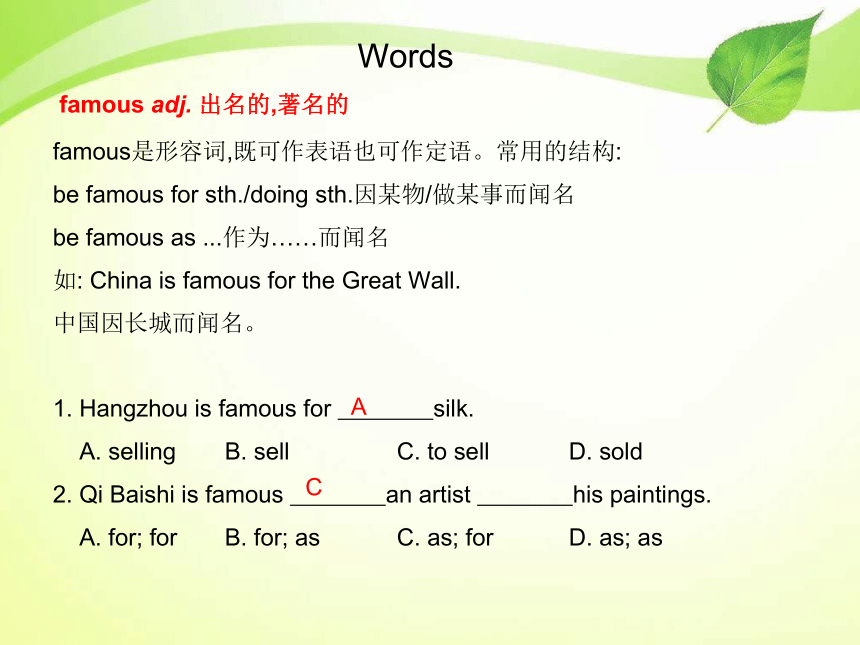
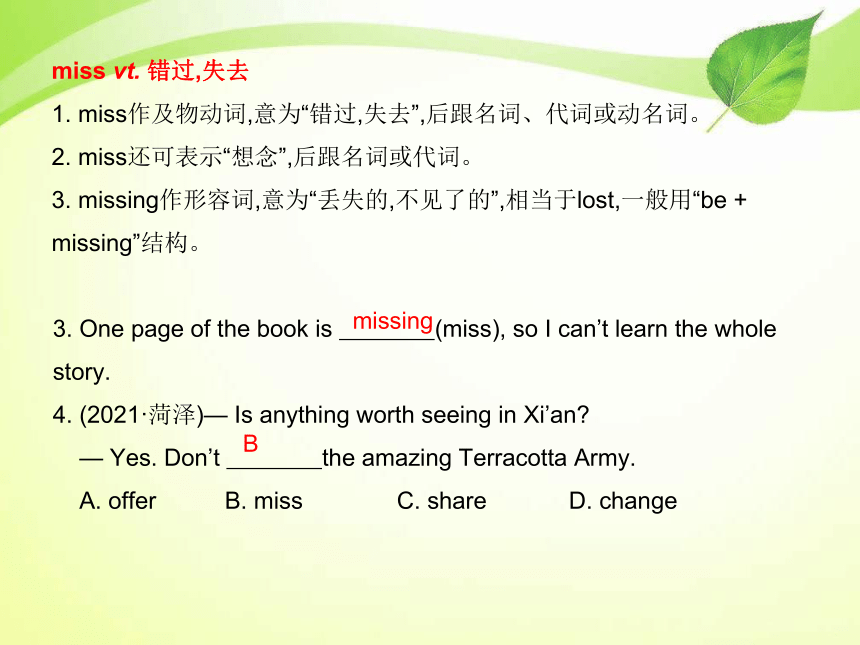
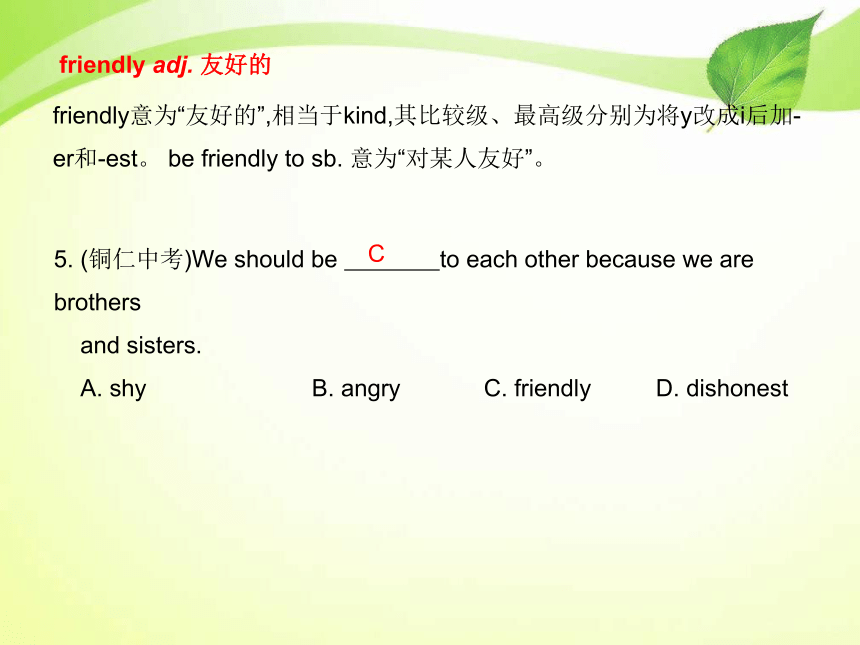
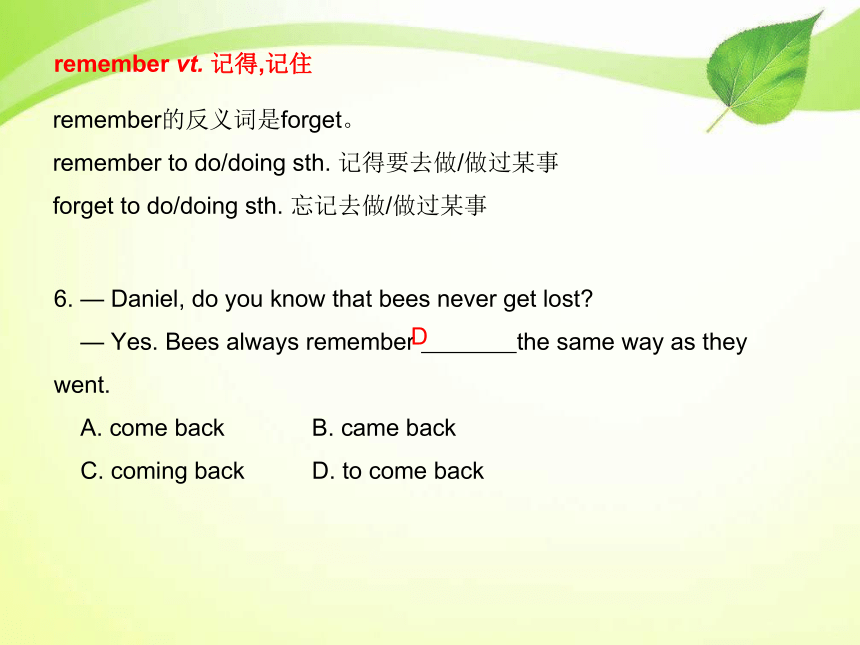

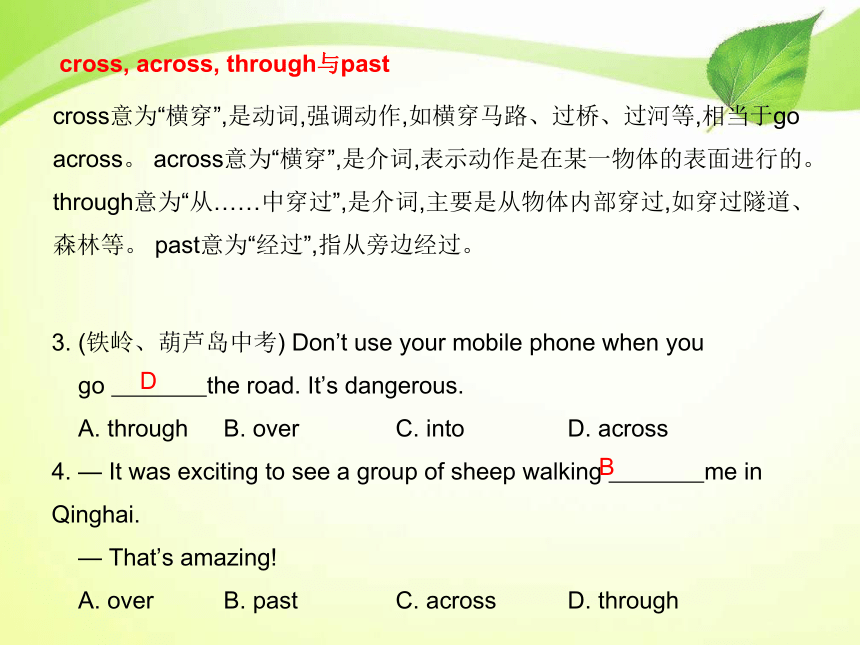
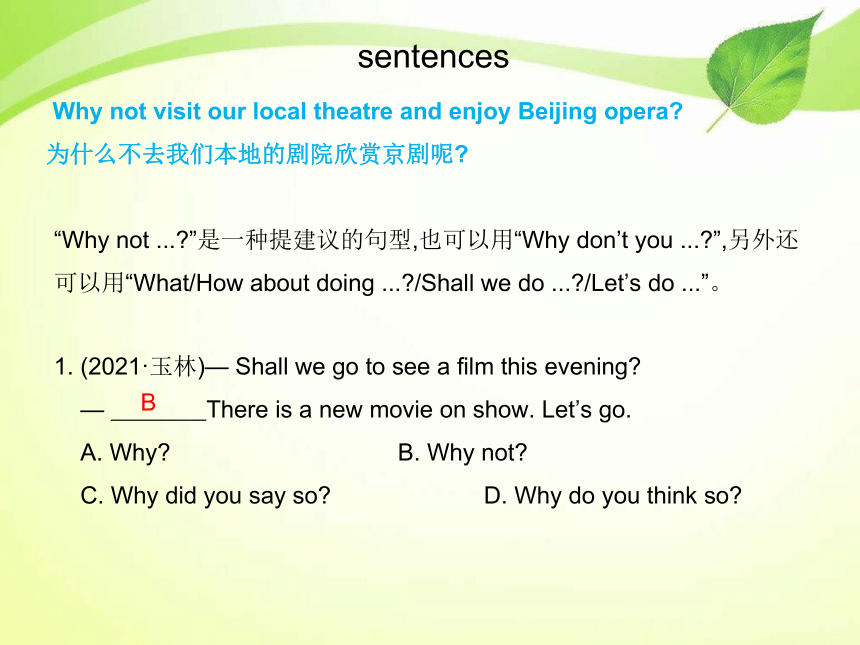
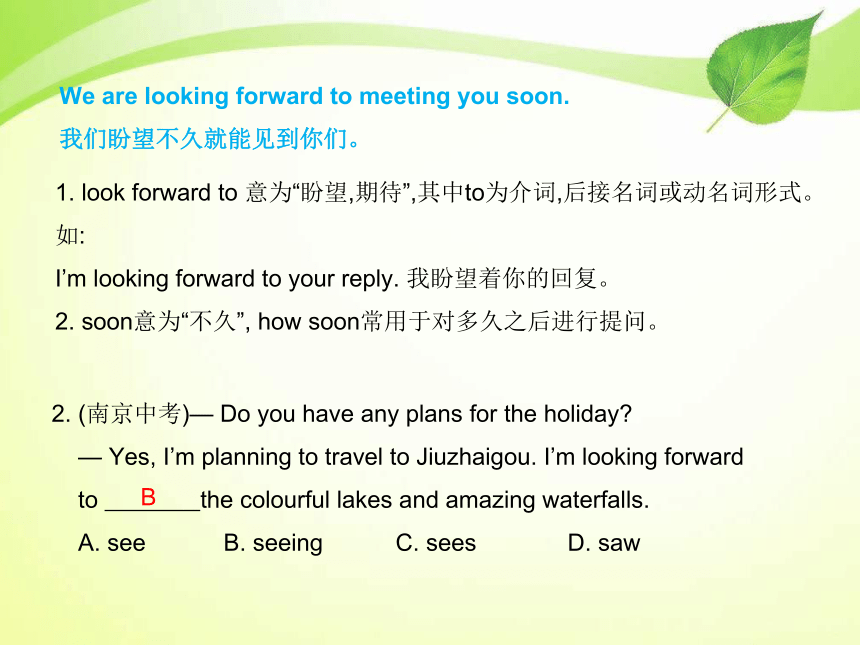
文档简介
(共20张PPT)
7B U3-4复习
(重点考点+练习)
famous adj. 出名的,著名的
famous是形容词,既可作表语也可作定语。常用的结构:
be famous for sth./doing sth.因某物/做某事而闻名
be famous as ...作为……而闻名
如: China is famous for the Great Wall.
中国因长城而闻名。
1. Hangzhou is famous for silk.
A. selling B. sell C. to sell D. sold
2. Qi Baishi is famous an artist his paintings.
A. for; for B. for; as C. as; for D. as; as
A
C
Words
miss vt. 错过,失去
1. miss作及物动词,意为“错过,失去”,后跟名词、代词或动名词。
2. miss还可表示“想念”,后跟名词或代词。
3. missing作形容词,意为“丢失的,不见了的”,相当于lost,一般用“be + missing”结构。
3. One page of the book is (miss), so I can’t learn the whole story.
4. (2021·菏泽)— Is anything worth seeing in Xi’an
— Yes. Don’t the amazing Terracotta Army.
A. offer B. miss C. share D. change
missing
B
friendly adj. 友好的
friendly意为“友好的”,相当于kind,其比较级、最高级分别为将y改成i后加-er和-est。 be friendly to sb. 意为“对某人友好”。
5. (铜仁中考)We should be to each other because we are brothers
and sisters.
A. shy B. angry C. friendly D. dishonest
C
remember vt. 记得,记住
remember的反义词是forget。
remember to do/doing sth. 记得要去做/做过某事
forget to do/doing sth. 忘记去做/做过某事
6. — Daniel, do you know that bees never get lost
— Yes. Bees always remember the same way as they went.
A. come back B. came back
C. coming back D. to come back
D
raise与rise
raise意为“升起;抬起;饲养;抚养;筹集;提高”,是及物动词,可以用于被动语态,过去式为raised,过去分词为raised。如:
He raised his head from the work.他停下他的工作抬起头来。
rise意为“上升,上涨;起立;起床”,常用于日、月、云、烟、河水、温度等,是不及物动词,不能用于被动语态,过去式为 rose,过去分词为risen。如:
The river rises as the rainstorm comes.随着暴雨来临,河水水位上涨。
1. (泰州泰兴模拟)The boy his hand and asked if the sun in the east every day.
A. rose; rises B. raised; raised C. raised; rises D. rises; raised
2. (无锡锡山东亭片模拟)The water in the river three feet last
night because of the sudden flood.
A. raised B. rose C. grew D. added
C
B
cross, across, through与past
cross意为“横穿”,是动词,强调动作,如横穿马路、过桥、过河等,相当于go across。 across意为“横穿”,是介词,表示动作是在某一物体的表面进行的。 through意为“从……中穿过”,是介词,主要是从物体内部穿过,如穿过隧道、森林等。 past意为“经过”,指从旁边经过。
3. (铁岭、葫芦岛中考) Don’t use your mobile phone when you
go the road. It’s dangerous.
A. through B. over C. into D. across
4. — It was exciting to see a group of sheep walking me in Qinghai.
— That’s amazing!
A. over B. past C. across D. through
D
B
Why not visit our local theatre and enjoy Beijing opera
为什么不去我们本地的剧院欣赏京剧呢
“Why not ... ”是一种提建议的句型,也可以用“Why don’t you ... ”,另外还可以用“What/How about doing ... /Shall we do ... /Let’s do ...”。
1. (2021·玉林)— Shall we go to see a film this evening
— There is a new movie on show. Let’s go.
A. Why B. Why not
C. Why did you say so D. Why do you think so
B
sentences
We are looking forward to meeting you soon.
我们盼望不久就能见到你们。
1. look forward to 意为“盼望,期待”,其中to为介词,后接名词或动名词形式。如:
I’m looking forward to your reply. 我盼望着你的回复。
2. soon意为“不久”, how soon常用于对多久之后进行提问。
2. (南京中考)— Do you have any plans for the holiday
— Yes, I’m planning to travel to Jiuzhaigou. I’m looking forward
to the colourful lakes and amazing waterfalls.
A. see B. seeing C. sees D. saw
B
Sunshine Zoo is north of Sunshine Middle School.
阳光动物园在阳光中学的北面。
A is in the east of B.(A地包括在B地的范围之内)
A is on the east of B.(A地和B地接壤)
A is (to the) east of B.(A地不包括在B地的范围内)
3. Yancheng, a beautiful city, lies the east of China.
A. in B. on C. to D. at
4. The USA is the south of Canada and the east of Japan.
A. to; in B. on; to C. in; beside D. at; on
A
B
Go straight on, and you’ll find the Panda House.
一直向前走,你们就会看到熊猫馆。
“祈使句+ and +陈述句”, and连接顺承关系;“祈使句+ or +陈述句”, or连接转折关系。如: Study hard, and you’ll pass the exam. 努力学习,你会通过考试的。Get up early, or you’ll be late for school. 早点起床,否则你上学会迟到。
5. (2021·绥化改编) it over, and you will be able to work out the
problem.
A. Thinking B. To think
C. Think D. To thinking
C
My parents will prepare plenty of food and drinks for us.
我的父母将为我们准备大量的食物和饮料。
plenty of意为“大量的,充裕的”,用来修饰可数名词和不可数名词,用法同a lot of/lots of。 plenty单独也可充当代词。
6. (2021·贵港)The Internet is very useful and it can offer p of
information to us.
7. For visitors to Guangzhou, there are places to experience its culture.
A. plenty B. plenty of C. a lot D. a lots of
lenty
B
名词所有格
概念:名词所有格用来表示人或物的所属关系,意为“……的”。
1. 大多数表示有生命的人或物的单数名词或者不以s结尾的复数名词,在其后加-’s。
2. 以s结尾的表示有生命的人或物的复数名词,通常只在s后加-’。
3. 表示几个人共同拥有的人或事物的名词,只在最后一个单词后加-’s。
4. 表示每个人各自拥有的人或事物的名词,在每个名词后加-’s。
grammar
1. (2021·淮安洪泽一调)One of those (leader) work is to make
development plans for their companies.
2. My uncle and aunt have a nice house! And this room is .
A. Jenny and Lucy’s B. Jenny’s and Lucy’s
C. Jenny’s and Lucy D. Jenny and Lucy
3. (内江中考)— Peter, how far is it from your home to school
— It’s only five walk.
A. minute B. minutes C. minute’s D. minutes’
4. (2021·盐城东台第四教育联盟一检)That shop on your right
sells clothes. Let’s have a look.
A. boy’s and men’s B. boys’ and mens’
C. boys’ and man’s D. boys’ and men’s
leaders’
A
D
D
物主代词
物主代词实际上是人称代词的所有格形式。物主代词可分为形容词性物主代词和名词性物主代词两种。形容词性物主代词后面一定要接名词;名词性物主代词独立使用,后面不需要接名词。物主代词的分类如下表:
单 数 复 数 形容词性 物主代词 名词性 物主代词 形容词性 物主代词 名词性
物主代词
第一人称 my mine our ours
第二人称 your yours your yours
第三人称 his, her, its his, hers, its their theirs
5. (2021·盘锦)These gloves belong to me. (she) are on the sofa.
6. Amy hid the iPad under desk in a hurry when her mother came in.
A. she B. her C. hers D. herself
7. (2021·盐城建湖一模)It’s known to all that the Chinese are famous
for hard work and wisdom.
A. they B. them C. their D. themselves
8. (2021·徐州新城中学模拟)His bike is broken. He asked if I would like to share with him.
A. me; his B. him; his C. me; mine D. I; mine
Hers
B
C
C
冠词
英语中冠词有三类,即不定冠词、定冠词和零冠词,不定冠词a/an常用来泛指某人或某物,定冠词the常用来特指某人或某物。
第一次提到某人或某物时,如果是可数名词单数,常在其前加不定冠词a/an。如:There is an apple tree over there. 那儿有一棵苹果树。
注意:1. a用在以辅音音素开头的单词前,而不是辅音字母前; an用在以元音音素开头的单词前,而不是元音字母前。
2. 谈到之前提过的某人或某物,或特指某人或某物时,常在其前加定冠词the。
3. 在西洋乐器名词前加定冠词。如: play the piano 弹钢琴
9. (2021·盐城)As an old saying goes, “He who has never been
to Great Wall is not a true man.”
A. a B. an C. the D. /
10. (2021·扬州)As teacher, it’s important to be good role model for his or her students.
A. the; a B. a; the C. a; a D. the; the
11. (2021·重庆B卷)I’m going to be great scientist like Yuan Longping when I grow up.
A. a B. an C. the D. /
12. France is European country. I have been there twice.
A. a B. / C. an D. the
C
C
A
A
方位介词
我们常用方位介词来表示物体的位置。常用的方位介词及介词短语有: inside, outside, above, below, over, under, in front of, behind, at, in, on, between等。
1. at与in: at的后面一般接小地点,而in的后面则接大地点。
2. in front of与behind: in front of意为“在……之前,在……面前”,表示有一定距离的前面,也可指在物体范围外的前面,反义词是behind。
3. beside, next to与near: beside指“在……旁边,在……附近”,常与near互换,但near指距离相对近一些。 相比之下, next to距离最近,表示“紧挨着,紧靠着”。
4. above, below, over, under与on: above指“在……上方”,反义词是below; over指“在……(垂直)正上方”,反义词是under。而on指的是“在……(物体)的上面”,指相互接触。
用适当的介词填空。
13. — Where is my ball I can’t see it.
— Look! It’s the door.
14. Don’t read the sun.
15. A plane is flying the clouds.
16. — Where is the light
— It’s just the table.
选择填空。
17. We planted some flowers the garden yesterday.
A. on B. to C. in D. of
18. (毕节中考)Communication is a bridge the young and the old.
A. across B. through C. between D. among
behind
in
above
over
C
C
7B U3-4复习
(重点考点+练习)
famous adj. 出名的,著名的
famous是形容词,既可作表语也可作定语。常用的结构:
be famous for sth./doing sth.因某物/做某事而闻名
be famous as ...作为……而闻名
如: China is famous for the Great Wall.
中国因长城而闻名。
1. Hangzhou is famous for silk.
A. selling B. sell C. to sell D. sold
2. Qi Baishi is famous an artist his paintings.
A. for; for B. for; as C. as; for D. as; as
A
C
Words
miss vt. 错过,失去
1. miss作及物动词,意为“错过,失去”,后跟名词、代词或动名词。
2. miss还可表示“想念”,后跟名词或代词。
3. missing作形容词,意为“丢失的,不见了的”,相当于lost,一般用“be + missing”结构。
3. One page of the book is (miss), so I can’t learn the whole story.
4. (2021·菏泽)— Is anything worth seeing in Xi’an
— Yes. Don’t the amazing Terracotta Army.
A. offer B. miss C. share D. change
missing
B
friendly adj. 友好的
friendly意为“友好的”,相当于kind,其比较级、最高级分别为将y改成i后加-er和-est。 be friendly to sb. 意为“对某人友好”。
5. (铜仁中考)We should be to each other because we are brothers
and sisters.
A. shy B. angry C. friendly D. dishonest
C
remember vt. 记得,记住
remember的反义词是forget。
remember to do/doing sth. 记得要去做/做过某事
forget to do/doing sth. 忘记去做/做过某事
6. — Daniel, do you know that bees never get lost
— Yes. Bees always remember the same way as they went.
A. come back B. came back
C. coming back D. to come back
D
raise与rise
raise意为“升起;抬起;饲养;抚养;筹集;提高”,是及物动词,可以用于被动语态,过去式为raised,过去分词为raised。如:
He raised his head from the work.他停下他的工作抬起头来。
rise意为“上升,上涨;起立;起床”,常用于日、月、云、烟、河水、温度等,是不及物动词,不能用于被动语态,过去式为 rose,过去分词为risen。如:
The river rises as the rainstorm comes.随着暴雨来临,河水水位上涨。
1. (泰州泰兴模拟)The boy his hand and asked if the sun in the east every day.
A. rose; rises B. raised; raised C. raised; rises D. rises; raised
2. (无锡锡山东亭片模拟)The water in the river three feet last
night because of the sudden flood.
A. raised B. rose C. grew D. added
C
B
cross, across, through与past
cross意为“横穿”,是动词,强调动作,如横穿马路、过桥、过河等,相当于go across。 across意为“横穿”,是介词,表示动作是在某一物体的表面进行的。 through意为“从……中穿过”,是介词,主要是从物体内部穿过,如穿过隧道、森林等。 past意为“经过”,指从旁边经过。
3. (铁岭、葫芦岛中考) Don’t use your mobile phone when you
go the road. It’s dangerous.
A. through B. over C. into D. across
4. — It was exciting to see a group of sheep walking me in Qinghai.
— That’s amazing!
A. over B. past C. across D. through
D
B
Why not visit our local theatre and enjoy Beijing opera
为什么不去我们本地的剧院欣赏京剧呢
“Why not ... ”是一种提建议的句型,也可以用“Why don’t you ... ”,另外还可以用“What/How about doing ... /Shall we do ... /Let’s do ...”。
1. (2021·玉林)— Shall we go to see a film this evening
— There is a new movie on show. Let’s go.
A. Why B. Why not
C. Why did you say so D. Why do you think so
B
sentences
We are looking forward to meeting you soon.
我们盼望不久就能见到你们。
1. look forward to 意为“盼望,期待”,其中to为介词,后接名词或动名词形式。如:
I’m looking forward to your reply. 我盼望着你的回复。
2. soon意为“不久”, how soon常用于对多久之后进行提问。
2. (南京中考)— Do you have any plans for the holiday
— Yes, I’m planning to travel to Jiuzhaigou. I’m looking forward
to the colourful lakes and amazing waterfalls.
A. see B. seeing C. sees D. saw
B
Sunshine Zoo is north of Sunshine Middle School.
阳光动物园在阳光中学的北面。
A is in the east of B.(A地包括在B地的范围之内)
A is on the east of B.(A地和B地接壤)
A is (to the) east of B.(A地不包括在B地的范围内)
3. Yancheng, a beautiful city, lies the east of China.
A. in B. on C. to D. at
4. The USA is the south of Canada and the east of Japan.
A. to; in B. on; to C. in; beside D. at; on
A
B
Go straight on, and you’ll find the Panda House.
一直向前走,你们就会看到熊猫馆。
“祈使句+ and +陈述句”, and连接顺承关系;“祈使句+ or +陈述句”, or连接转折关系。如: Study hard, and you’ll pass the exam. 努力学习,你会通过考试的。Get up early, or you’ll be late for school. 早点起床,否则你上学会迟到。
5. (2021·绥化改编) it over, and you will be able to work out the
problem.
A. Thinking B. To think
C. Think D. To thinking
C
My parents will prepare plenty of food and drinks for us.
我的父母将为我们准备大量的食物和饮料。
plenty of意为“大量的,充裕的”,用来修饰可数名词和不可数名词,用法同a lot of/lots of。 plenty单独也可充当代词。
6. (2021·贵港)The Internet is very useful and it can offer p of
information to us.
7. For visitors to Guangzhou, there are places to experience its culture.
A. plenty B. plenty of C. a lot D. a lots of
lenty
B
名词所有格
概念:名词所有格用来表示人或物的所属关系,意为“……的”。
1. 大多数表示有生命的人或物的单数名词或者不以s结尾的复数名词,在其后加-’s。
2. 以s结尾的表示有生命的人或物的复数名词,通常只在s后加-’。
3. 表示几个人共同拥有的人或事物的名词,只在最后一个单词后加-’s。
4. 表示每个人各自拥有的人或事物的名词,在每个名词后加-’s。
grammar
1. (2021·淮安洪泽一调)One of those (leader) work is to make
development plans for their companies.
2. My uncle and aunt have a nice house! And this room is .
A. Jenny and Lucy’s B. Jenny’s and Lucy’s
C. Jenny’s and Lucy D. Jenny and Lucy
3. (内江中考)— Peter, how far is it from your home to school
— It’s only five walk.
A. minute B. minutes C. minute’s D. minutes’
4. (2021·盐城东台第四教育联盟一检)That shop on your right
sells clothes. Let’s have a look.
A. boy’s and men’s B. boys’ and mens’
C. boys’ and man’s D. boys’ and men’s
leaders’
A
D
D
物主代词
物主代词实际上是人称代词的所有格形式。物主代词可分为形容词性物主代词和名词性物主代词两种。形容词性物主代词后面一定要接名词;名词性物主代词独立使用,后面不需要接名词。物主代词的分类如下表:
单 数 复 数 形容词性 物主代词 名词性 物主代词 形容词性 物主代词 名词性
物主代词
第一人称 my mine our ours
第二人称 your yours your yours
第三人称 his, her, its his, hers, its their theirs
5. (2021·盘锦)These gloves belong to me. (she) are on the sofa.
6. Amy hid the iPad under desk in a hurry when her mother came in.
A. she B. her C. hers D. herself
7. (2021·盐城建湖一模)It’s known to all that the Chinese are famous
for hard work and wisdom.
A. they B. them C. their D. themselves
8. (2021·徐州新城中学模拟)His bike is broken. He asked if I would like to share with him.
A. me; his B. him; his C. me; mine D. I; mine
Hers
B
C
C
冠词
英语中冠词有三类,即不定冠词、定冠词和零冠词,不定冠词a/an常用来泛指某人或某物,定冠词the常用来特指某人或某物。
第一次提到某人或某物时,如果是可数名词单数,常在其前加不定冠词a/an。如:There is an apple tree over there. 那儿有一棵苹果树。
注意:1. a用在以辅音音素开头的单词前,而不是辅音字母前; an用在以元音音素开头的单词前,而不是元音字母前。
2. 谈到之前提过的某人或某物,或特指某人或某物时,常在其前加定冠词the。
3. 在西洋乐器名词前加定冠词。如: play the piano 弹钢琴
9. (2021·盐城)As an old saying goes, “He who has never been
to Great Wall is not a true man.”
A. a B. an C. the D. /
10. (2021·扬州)As teacher, it’s important to be good role model for his or her students.
A. the; a B. a; the C. a; a D. the; the
11. (2021·重庆B卷)I’m going to be great scientist like Yuan Longping when I grow up.
A. a B. an C. the D. /
12. France is European country. I have been there twice.
A. a B. / C. an D. the
C
C
A
A
方位介词
我们常用方位介词来表示物体的位置。常用的方位介词及介词短语有: inside, outside, above, below, over, under, in front of, behind, at, in, on, between等。
1. at与in: at的后面一般接小地点,而in的后面则接大地点。
2. in front of与behind: in front of意为“在……之前,在……面前”,表示有一定距离的前面,也可指在物体范围外的前面,反义词是behind。
3. beside, next to与near: beside指“在……旁边,在……附近”,常与near互换,但near指距离相对近一些。 相比之下, next to距离最近,表示“紧挨着,紧靠着”。
4. above, below, over, under与on: above指“在……上方”,反义词是below; over指“在……(垂直)正上方”,反义词是under。而on指的是“在……(物体)的上面”,指相互接触。
用适当的介词填空。
13. — Where is my ball I can’t see it.
— Look! It’s the door.
14. Don’t read the sun.
15. A plane is flying the clouds.
16. — Where is the light
— It’s just the table.
选择填空。
17. We planted some flowers the garden yesterday.
A. on B. to C. in D. of
18. (毕节中考)Communication is a bridge the young and the old.
A. across B. through C. between D. among
behind
in
above
over
C
C
同课章节目录
